List of the rulers of the Principality of Lüneburg
The list of the rulers of the Principality of Lüneburg contains all the rulers of the Principality of Lüneburg from 1269 until the Principality fell to the Electorate of Braunschweig-Lüneburg in 1705.
Owners of the imperial fief were the Guelph Dukes of Braunschweig-Lüneburg and during the War of the Lüneburg Succession from 1370 to 1388 the Ascanian Dukes of Wittenberg. Due to an agreement in the deed of division of 1269, all Guelph dukes of the entire house of Braunschweig-Lüneburg carried the title of Duke of Braunschweig-Lüneburg even after the division .
The coats of arms of the Lüneburg princes have been changed and expanded several times over the centuries. The main coat of arms of the Principality of Lüneburg depicts a blue, erect lion in a golden shield . In the 14th century, it was combined with the arms of the Brunswick line of the Welfenhaus , which shows two golden leopards on a red background. In the 15th and 16th centuries, the coat of arms was then expanded to include the coat of arms of the newly acquired territories Everstein, Homburg, Hoya , Diepholz and the coat of arms of the Harz counties of Lauterberg, Klettenberg , Hohnstein, Regenstein and Blankenburg, which are connected to the Brunswick principality .
Ruler of the Principality of Lüneburg
Old house Lueneburg
| The division of the Duchy of Braunschweig-Lüneburg between Albrecht I and Johann created the principalities of Braunschweig and Lüneburg in 1269 . Johann founded the old house in Lüneburg . |
| Portrait | Name (life data) |
Reign | Wife (marriage year) |
Remarks |
|---|---|---|---|---|

|
Johann I (1242-1277) |
1269-1277 | Luitgard of Holstein (1265) |
Acquired the city of Uelzen and granted it city rights in 1270 and promoted the development of the saltworks in Lüneburg. |
| Since Otto II was under the age of majority at the time of his father's death, a guardianship government led by Prince Albrecht of Brunswick and Bishop Konrad of Verden took over the government from 1277 to 1282. | ||||

|
Otto II, ( the Strict ) (1266-1330) |
1282-1330 | Matilde of Bavaria (1288) |
Continued the acquisition policy and territorial consolidation of its predecessors. By selling the minting rights to the cities of Lüneburg and Hanover, reorganized the coinage in the principality. Awarded city rights to Harburg (1288), Dahlenburg (1289) and Celle (1292). |

|
Otto III. (1296-1352) |
1330-1352 | Matilde of Mecklenburg (1310) |
Exercised the government together with his brother Wilhelm II. Acquired the village of Fallersleben, the counties of Papenteich and Wettmarshagen, thereby strengthening the ducal power in the Gifhorn area. Supported the economically emerging cities. |

|
Wilhelm II. († 1369) |
1330-1369 | Hedwig von Ravensberg (before 1328) Marie (after 1336) Sophie von Anhalt Berneburg (1346) Agnes von Sachsen-Lauenburg (1363) |
Practiced together with his brother Otto III. the government off. Acquired the village of Fallersleben, the counties of Papenteich and Wettmarshagen, thereby strengthening the ducal power in the Gifhorn area. Supported the economically emerging cities. His death triggered the War of the Lüneburg Succession in 1370. |
Old house Braunschweig
| After Wilhelm's death , Magnus Torquatus , who belonged to the old house of Braunschweig , inherited the principality. |
| Portrait | Name (life data) |
Reign | Wife (marriage year) |
Remarks |
|---|---|---|---|---|
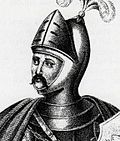
|
Magnus, Torquatus (1328-1373) |
1369-1373 | Katharina von Anhalt (before 1356) |
Inherited both the Lüneburg and Brunswick principality. Died of fatal injuries in a duel at the Battle of the Deister. |
Dukes of Saxe-Wittenberg
| In addition to Magnus Torquatus , the Ascanian dukes of Wittenberg also laid claim to the principality. This led to the Lüneburg War of Succession. |
| Portrait | Name (life data) |
Reign | Wife (marriage year) |
Remarks |
|---|---|---|---|---|

|
Albrecht († 1385) |
1370-1385 | Katharina von Anhalt (before 1374) |
After the razing of Lüneburg Castle, Albrecht moved the residence to Celle in 1378. Was enfeoffed with the principality after Wilhelm's death by Emperor Karl IV. This triggered the War of the Lüneburg Succession. Married the widow of Duke Magnus on the basis of a peace treaty. |

|
Wenceslas (around 1337-1388) |
1370-1388 | Cecilia of Carrara (1371 or 1376) |
Was enfeoffed together with his nephew Albrecht by Emperor Karl IV. With the Lüneburg principality, this triggered the Lüneburg War of Succession. Died in 1388 during the siege of Celle. Was buried in the Michaeliskirche in Lüneburg. |
Middle House Braunschweig
| After the War of Succession, the principalities of Braunschweig and Lüneburg were divided again in 1388. Heinrich I der Milde took over Lüneburg together with his brother and founded the Middle House of Braunschweig . |
| Portrait | Name (life data) |
Reign | Wife (marriage year) |
Remarks |
|---|---|---|---|---|

|
Heinrich, the Meek († 1416) |
1388-1416 | Sophie of Pomerania (1388) Margaret of Hesse (1409) |
Was nicknamed "King of the Haide". Ruled both in the Principality of Braunschweig and in the Principality of Lüneburg. |
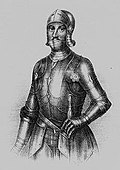
|
Wilhelm the Victorious (1392–1482) |
1416-1428 |
Cäcilie von Brandenburg (1423) Matilde von Holstein-Schauenburg (1466) |
Was nicknamed the Victorious . Ruled together with his brother Heinrich II. Founded the Principality of Calenberg. |

|
Heinrich the Peaceful (1411–1473) |
1416-1428 | Helene of Kleve (1435) |
Ruled together with his brother Wilhelm. Was nicknamed the Peaceful because, unlike his brother, he avoided armed conflicts. |
Middle House Lüneburg
| After another division of the Guelph principalities, Bernhard I took over Lüneburg in 1428 and founded the Middle House of Lüneburg . |
| Portrait | Name (life data) |
Reign | Wife (marriage year) |
Remarks |
|---|---|---|---|---|

|
Bernhard († 1434) |
1388-1409 and 1428-1434 |
Margaret of Saxony-Wittenberg (1385) |
Spent three years in captivity with Herr von Schwichelde. Signed a contract with the Wittenberg Dukes to end the War of the Lüneburg Succession. |
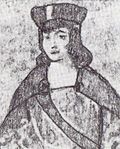
|
Otto the limping († 1446) |
1434-1446 | Elisabeth von Eberstein (1425) |
Exercised the government together with his brother Friedrich the Pious. Had the Celle Castle rebuilt. Improved the legal situation of the farmers towards the landlords. |

|
Friedrich the Pious († 1478) |
1434-1457 and 1472-1478 |
Magdalena of Brandenburg (1430) |
Had a monastery built in Celle. In 1457 he gave up the government to his son Bernhard II and retired to the monastery as a benefactor. After Bernhard II died in 1464 and his brother Otto in 1471, he took over the government again until his death. |

|
Bernhard (1432–1464) |
1457-1464 | Matilde of Holstein-Schauenburg (1463) |
Was elected Bishop of Hildesheim in 1452. In 1457, at the request of his father, left the monastery to take over the government in the Principality of Lüneburg. His marriage in 1463 remained childless. |
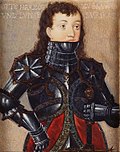
|
Otto the Victorious (1439–1471) |
1464-1471 |
Anna of Nassau-Dillenburg (1467) |
After the death of his brother, he took over the government and supported the monastic reform movement. According to legend, he died in an accident on the Stechbahn in Celle, a horseshoe in the ground reminds of it. |
| From 1478 to 1486, Anna von Nassau took over the government for her underage son Heinrich the Middle with the participation of the estates . | ||||

|
Heinrich, the Middle (1468–1532) |
1486-1520 |
Margaret of Saxony (1487) |
Went to the French royal court in 1520 in anticipation of the imperial ban that was pronounced against him a year later. Returned from exile in 1527 and tried to take over the government with Catholic believers and to reverse the Reformation, but failed. |

|
Ernst the Confessor (1497–1546) |
1520-1546 | Sophia of Mecklenburg (1528) |
In 1527 he introduced the Reformation in the Principality of Lüneburg to the Landtag of Scharnebeck. Due to the co-signing of the Augsburg Confession, he was nicknamed the Confessors in the 18th century . Other priorities of his government were the rehabilitation of the indebted principality and the modernization of the administration. |
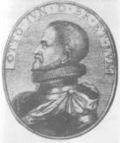
|
Otto (1495–1549) |
1520-1527 | Meta of Campe (1527) |
Initially exercised the government in the Principality of Lüneburg together with his brother. Married the unequal Meta von Campe in 1527 and was resigned to his own domain, the rule of Harburg on the Elbe at Harburg Castle. |

|
Franz (1508–1549) |
1536-1539 |
Clare of Saxe-Lauenburg (1547) |
Initially exercised the government in the Principality of Lüneburg together with his brother. Resigned from the government in 1539 and was resigned to the rule of Gifhorn. Had Gifhorn Castle expanded as a residence. |
| Since Ernst the Confessor's sons were underage when he died, a guardianship government made up of governors and councilors under the leadership of the Archbishop of Cologne and the Count of Schaumburg took over the government from 1546 to 1555. | ||||

|
Franz Otto (1530–1559) |
1555-1559 |
Elisabeth Magdalene of Brandenburg (1559) |
Died three months after his marriage, his marriage remained childless. |
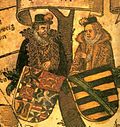
|
Heinrich (1533–1598) |
1559-1569 |
Ursula of Saxe-Lauenburg (1569) |
In 1569, contrary to what had been agreed with his brother Ursula von Sachsen Lauenburg, he married. Resigned from the government in the same year and was resigned to the Dannenberg rule. |
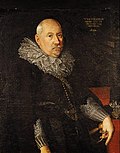
|
Wilhelm the Younger (1535–1592) |
1559-1592 |
Dorothea of Denmark (1561) |
Issued church ordinances in 1562 and practically brought the Reformation in the principality to a close. Issued a confession, the Corpus Doctrinae Wilhelminum . Spent the last few years mentally deranged and was no longer able to lead the government. |
| Due to a mental illness, Wilhelm was no longer able to exercise his office since 1587. Under the direction of Phillip von Grubenhagen and Wilhelm's wife Dorothea , a government of governors and councilors took over the administration of the principality. | ||||

|
Ernst II (1564-1611) |
1592-1611 | single | Under him, the Celle family contract of 1610 was concluded, which should ensure the indivisibility of the principality. |
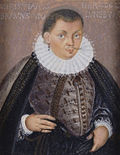
|
Christian, the Elder (1566–1633) |
1611-1633 | single | Tried to keep the Principality of Lüneburg out of the Thirty Years' War and tried to achieve armed neutrality . |

|
August the Elder (1568-1636) |
1633-1636 | single | Continued the neutrality policy started by his brother in the Thirty Years War. Had 12 children with the officer's daughter Ilse Schmidichen who were raised to the nobility under the name of Lüneburg. |
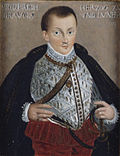
|
Friedrich (1574–1648) |
1636-1648 | single | Dismissed the Guelph army and thereby weakened his negotiating position in the peace negotiations in Munster. |
New house in Lüneburg
| The children of Wilhelm the Younger agreed that only one of them should marry appropriately and continue the lineage. The lot fell on the second youngest Georg von Calenberg, who founded the New House in Lüneburg . However, he himself did not rule in Lüneburg, only his son Christian Ludwig took over the principality in 1648. |
| Portrait | Name (life data) |
Reign | Wife (marriage year) |
Remarks |
|---|---|---|---|---|

|
Christian Ludwig (1622–1665) |
1648-1665 |
Dorothea Sophie of Schleswig-Holstein-Sonderburg-Glücksburg (1653) |
His marriage to Dorothea von Holstein remained childless. He set the heron stake in Altenhagen, which is still there today. |

|
Johann Friedrich (1625–1679) |
1665 |
Benedicta Henriette of the Palatinate (1668) |
After the death of his brother Christian Ludwig in 1665, he took over the government in Celle like a coup d'état, but had to surrender the principality to his older brother Georg Wilhelm. Converted to Catholic Faith. |

|
Georg Wilhelm (1624–1705) |
1665-1705 |
Eleonore d'Olbreuse (1676) |
Became known as the Heath Duke . Had the palace theater and the French garden built in Celle. Last Duke in Celle - after his death the Principality fell to the Electorate of Hanover. |
| In 1705 the Principality of Lüneburg fell by inheritance to the Electorate of Braunschweig-Lüneburg . |
|---|
literature
- Wilhelm Havemann : History of the Lands of Braunschweig and Lüneburg , 3 vol., Reprint. Hirschheydt, Hannover 1974/75, ISBN 3-7777-0843-7 (original edition: Verlag der Dietrich'schen Buchhandlung, Göttingen 1853-1857)
- Hans Patze (term): History of Lower Saxony , 7 vols. Hahnsche Buchhandlung, Hanover 1977- (Publications of the Historical Commission for Lower Saxony and Bremen, 36)
- Christa Geckler: The Celle dukes - life and work 1371-1705 , Georg Ströher Celle 1986, ISBN 3-921744-05-8
Web links
Individual evidence
- ^ For the life of Johann see: Karl Janicke: Johann, Duke of Braunschweig . In: Allgemeine Deutsche Biographie (ADB). Volume 14, Duncker & Humblot, Leipzig 1881, p. 177.
- ↑ For the life of Otto II. See: Uwe Ohainski: Otto II., Der Strenge. In: New German Biography (NDB). Volume 19, Duncker & Humblot, Berlin 1999, ISBN 3-428-00200-8 , p. 679 f. ( Digitized version ).
- ↑ On the life of Otto III. see the biography of his brother: Paul Zimmermann : Wilhelm, Duke of Braunschweig-Lüneburg . In: Allgemeine Deutsche Biographie (ADB). Volume 42, Duncker & Humblot, Leipzig 1897, pp. 730-733.
- ↑ For the life of Wilhelm II see: Paul Zimmermann : Wilhelm, educated from Braunschweig-Lüneburg . In: Allgemeine Deutsche Biographie (ADB). Volume 42, Duncker & Humblot, Leipzig 1897, pp. 730-733.
- ↑ On the life of Magnus II. See: Bernd-Ulrich Hergemöller: Magnus II. In: Neue Deutsche Biographie (NDB). Volume 15, Duncker & Humblot, Berlin 1987, ISBN 3-428-00196-6 , p. 662 f. ( Digitized version ).
- ^ For the life of Albrecht see: Herbert Mundhenke: Albrecht (Albert). In: New German Biography (NDB). Volume 1, Duncker & Humblot, Berlin 1953, ISBN 3-428-00182-6 , p. 173 f. ( Digitized version ).
- ↑ For the life of Wenzel see: W. von Sommerfeld: Wenzel . In: Allgemeine Deutsche Biographie (ADB). Volume 41, Duncker & Humblot, Leipzig 1896, p. 735 f.
- ↑ On the life of Heinrich I see: Ferdinand Spehr: Heinrich, Herzog von Braunschweig . In: Allgemeine Deutsche Biographie (ADB). Volume 11, Duncker & Humblot, Leipzig 1880, pp. 486-488.
- ↑ For the life of Wilhelm I see: Paul Zimmermann : Wilhelm der Aeltere . In: Allgemeine Deutsche Biographie (ADB). Volume 42, Duncker & Humblot, Leipzig 1897, pp. 733-738.
- ↑ For the life of Heinrich II. See: Ferdinand Spehr: Heinrich der Friedfertige . In: Allgemeine Deutsche Biographie (ADB). Volume 11, Duncker & Humblot, Leipzig 1880, pp. 489-491.
- ↑ For the life of Bernhard I. see: Herbert Mundhenke : Bernhard I .. In: Neue Deutsche Biographie (NDB). Volume 2, Duncker & Humblot, Berlin 1955, ISBN 3-428-00183-4 , p. 109 f. ( Digitized version ).
- ↑ On the life of Otto IV. See: Christa Geckler: Die Celler Herzöge - Leben und Wirken 1371-1705 , Georg Ströher Celle 1986, ISBN 3-921744-05-8 , p. 31.
- ↑ On the life of Friedrich the Pious, see: Christa Geckler: Die Celler Herzöge - Leben und Wirken 1371-1705 , Georg Ströher Celle 1986, ISBN 3-921744-05-8 , p. 32.
- ↑ For the life of Bernhard see: Ferdinand Spehr: Bernhard von Braunschweig-Lüneburg . In: Allgemeine Deutsche Biographie (ADB). Volume 2, Duncker & Humblot, Leipzig 1875, p. 418.
- ↑ On the life of Otto V. see: Christa Geckler: Die Celler Herzöge - Leben und Wirken 1371-1705 , Georg Ströher Celle 1986, ISBN 3-921744-05-8 , p. 37.
- ↑ For the life of Heinrich the Middle, see: Heinrich Schmidt: Heinrich the Middle. In: New German Biography (NDB). Volume 8, Duncker & Humblot, Berlin 1969, ISBN 3-428-00189-3 , p. 350 f. ( Digitized version ).
- ↑ On the life of Ernst the Confessor see: Klaus Friedland: Ernst, Duke of Braunschweig-Lüneburg-Celle. In: New German Biography (NDB). Volume 4, Duncker & Humblot, Berlin 1959, ISBN 3-428-00185-0 , p. 608 ( digitized version ).
- ↑ For the life of Otto I. see: Christa Geckler: Die Celler Herzöge - Leben und Wirken 1371–1705. Georg Ströher Celle 1986, ISBN 3-921744-05-8 , p. 49.
- ↑ For the life of Franz see: Christa Geckler: The Celler dukes - life and work 1371–1705. Georg Ströher Celle 1986, ISBN 3-921744-05-8 , p. 49.
- ↑ For the life of Franz Otto see: Christa Geckler: Die Celle dukes - life and work 1371–1705. Georg Ströher Celle 1986, ISBN 3-921744-05-8 , p. 59.
- ↑ For the life of Heinrich see: Christa Geckler: Die Celle dukes - life and work 1371–1705. Georg Ströher Celle 1986, ISBN 3-921744-05-8 , p. 65.
- ↑ For the life of Wilhelm the Younger see: Christa Geckler: The Celle dukes - life and work 1371–1705. Georg Ströher Celle 1986, ISBN 3-921744-05-8 , p. 59.
- ↑ On the life of Ernst II. See: Wilhelm Sauer: Ernst II., Duke of Braunschweig-Lüneburg . In: Allgemeine Deutsche Biographie (ADB). Volume 6, Duncker & Humblot, Leipzig 1877, p. 261.
- ↑ For the life of Christian see: Christa Geckler: The Celler dukes - life and work 1371–1705. Georg Ströher Celle 1986, ISBN 3-921744-05-8 , p. 70.
- ↑ For the life of August I see: Christa Geckler: Die Celle dukes - life and work 1371–1705. Georg Ströher Celle 1986, ISBN 3-921744-05-8 , p. 73.
- ↑ On the life of Frederick IV. See: Christa Geckler: Die Celle dukes - life and work 1371–1705. Georg Ströher Celle 1986, ISBN 3-921744-05-8 , p. 74.
- ↑ For the life of Christian Ludwig see: Christa Geckler: Die Celle dukes - life and work 1371–1705. Georg Ströher Celle 1986, ISBN 3-921744-05-8 , p. 79.
- ↑ For the life of Johann Friedrich see: Adolf Köcher: Johann Friedrich, Duke of Braunschweig-Lüneburg (Hanover) . In: Allgemeine Deutsche Biographie (ADB). Volume 14, Duncker & Humblot, Leipzig 1881, pp. 177-181., P. 83.
- ↑ For the life of Georg Wilhelm see: Christa Geckler: The Celle dukes - life and work 1371–1705. Georg Ströher Celle 1986, ISBN 3-921744-05-8 , p. 83.
